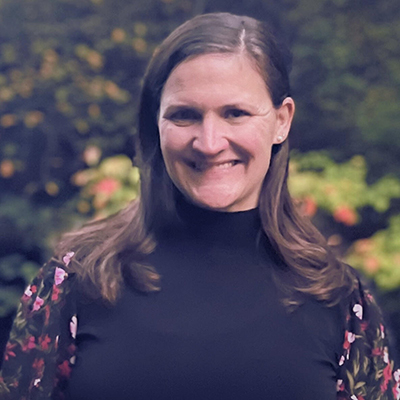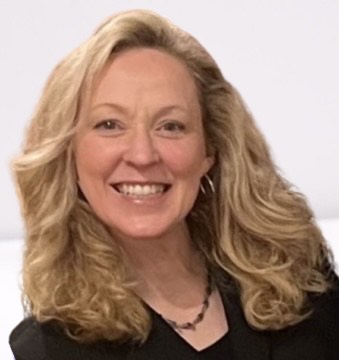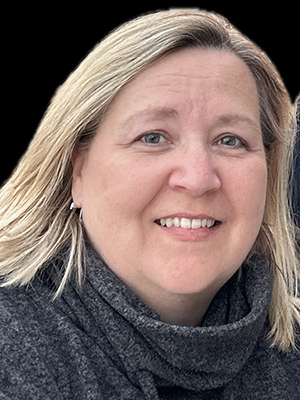For the Love of Learning

“From the moment I saw my daughters’ faces light up when they ‘got it,’ I knew that providing children with access to knowledge was my passion.” These are the words of December’s Featured Educator, Lee Tighe. After raising her children and working outside of education for many years, Lee found her true calling and entered the teaching profession. “I had a degree in business administration, but knew that I wanted to become a teacher and do the job I love to do,” said Tighe.
Along her journey to become an educator, Lee realized that she loved all learning through both traditional and digital methods. When she started teaching, she felt like the only person in the world who changed careers but remembers meeting someone else who also switched later in life. “I quickly learned that the greatest resource I had available was found in my colleagues. I’ve been lucky enough to work with educators who share ideas, ask questions, and seek solutions,” she said. Now with twenty years in education, Lee continues her own love of learning and knows how important it is to embrace change.
An Integrated Practice
While Tighe stood in front of her students with markers and whiteboards, she quickly recognized that her students were coming from a growing digital environment. “That early experience set me to seek out methods of bringing technology into the classroom and led me to the technology of the day–instructional games”, states Lee, who soon realized that plugging children into educational games was fun for the kids, but did not provide quite enough. “Students still have a lot pushed at them,” says Tighe. She believes in the theory of ‘not yet’ to teach the importance of learning by sometimes failing. “They still have pressure to keep up with a set pace and we can’t always give them the time.” Time on learning is something Tighe would love for her students to have more of and she is hopeful that someday that pacing will change. Her biggest concern is supporting the struggling student. Since she teaches ELA and Science, Tighe is able to integrate the two content areas with meaningful learning experiences. “For ELA, I start with high expectations for close reading with nonfiction-based on Science.” states Tighe. “This integration provides content with purpose, ensuring I have different access points to get students talking and listening so they can experience their learning and not just hear my voice.” An example Tighe cites is how visually cued in her learners are. “Students are more and more visual, so I try to make sure there’s some sort of visual component,” states Tighe.
Technology as a Resource
Tighe sees technology as a great resource when it is pedagogically relevant. “Visuals such as video and models, as well as various web platforms, enrich the information that I plan to teach my students”, she said. This helps lead Tighe’s students to discovery, giving them rich visual and hands-on connections that make learning real. “If it makes sense for their assessment, I encourage them to show their learning through their own incorporation of technology with visual models using tools such as Google Slides, BrainPop Make-A-Movie, and FlipGrid.” Lee believes that good pedagogy is found when teachers lead students to discovery through various methods. “To provide the learner the stimulation that drives motivation, access to consume and share their learning…that’s my role,” states Lee.
“I love using FlipGrid as a tool to share student voice. In class, every teacher has their students who love to participate, but we always struggle to get those reluctant speakers. FlipGrid has allowed me to see the great ideas of so many reluctant speakers! And it may have started the paths of some future YouTube Stars!” said Tighe. She also likes Padlet, which is great tool for collaboration and voice. “Students love responding to the prompts as well as each other’s comments. We have used Padlet in discussions within and well beyond our four walls during the Global Read Aloud.” Tighe has also tapped into her students’ love of sharing ideas through photography, as well as Twitter. “I find that students love to share their ideas, questions and knowledge through photography. We open the idea of ‘Nature Go’ which is born of “Pokemon Go” in that images are ‘captured’ and interest in looking at our world is heightened. Their work is printed and posted on a bulletin board that provides a lot of student interest.” Tighe has also recently started tweeting student comments around their learning. “They love knowing that their ideas are being shared with people other than me!” she said. “That type of learning is dynamic and unforgettable!”
Curiosity-Based Learning
One of Tighe’s most notable contributions is helping to bring Mystery Science to her school. Mystery Science is a curiosity-crafted science program that incorporates technology with good pedagogy. This well designed, user-friendly tool motivates students with opportunities to share and hone their ideas as it goes along. According to Lee, the designers believe in curiosity learning with every lesson beginning with a student posed question, as well as plenty of opportunity for discussion, whether it is whole group or turn and talk. “The program leads the students to discovery while incorporating vocabulary and information, along with visual and auditory support. The students are given a hands-on challenge to solve that leads them to the answer to the question posed at the opening.” states Tighe. The materials used by the students are usually household items, or easily found. “I find that tech reluctant teachers consider the program well-designed with clearly defined standards, materials needed, and well-placed stopping spots in videos for teachers to lead discussion or add information.”
Empowered Students
As a 5th grade teacher, Tighe recognizes that many students are just realizing their own individuality and their own potential power. Many are still waiting to be told what to do or think. “At this level, I get to guide them to read, watch, listen, think and respond. We can take that path beyond our classroom and recognize an important responsibility toward areas beyond ourselves. They are also just beginning to have some independence through online platforms. It is crucial that they recognize their responsibilities online as they do in person.” said Tighe. “Their voice, whether spoken or written, has power and responsibility. I am working hard to help them realize both.”
Pathways to Personal Growth
Tighe encourages others to collaborate both inside and beyond their schools. “Talk with your colleagues in the building, get on social media and meet educators outside of the building. Also be sure to listen to webinars and TED talks, attend conferences, and edcamps to meet curious people and seek out connections that will provide you and your students with diverse learning opportunities.”
Lee Tighe is a 5th grade teacher at the Jordan/Jackson Elementary School in Mansfield. Follow her on Twitter: @tighe_lee
 Print this post
Print this post



